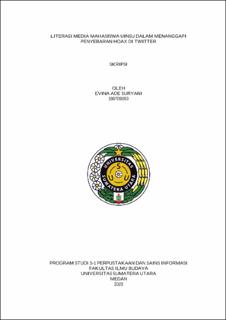| dc.description.abstract | The study concludes that UINSU students demonstrate proficient media literacy skills, with room for improvement in updating existing knowledge structures. This study aims to assess students' media literacy skills in responding to the spread of hoaxes on Twitter at the State Islamic University of North Sumatra located on Willem Iskandar Street, Pasar V, Medan Estate, Percut Sei Tuan District, Deli Serdang Regency, North Sumatra. This descriptive qualitative research collected data through observation, interviews, and documentation. The interview used a purposive sampling technique to determine five students as informants. Based on the media literacy theory by James Potter, there are seven abilities, namely analysis, evaluation, categorization, induction, deduction, synthesis, and abstraction. The results of this study showed that two out of five informants demonstrated proficiency in all media literacy indicators. In the analysis indicator, all informants know what, where, when, why, who, and how the information was obtained through Twitter. On the evaluation indicator, four out of five informants were adept at evaluating information by comparing it with other sources. All informants demonstrated proficiency in categorizing information by recognizing differing perspectives in the categorization indicator. On the induction indicator, four out of five demonstrated the ability to draw general conclusions from the information received. On the deduction indicator, four out of five informants recognized the limitations of deductive reasoning in media content. On the synthesis indicator, two out of five informants exhibited the capacity to update and refine their knowledge structure. In the abstraction indicator, all informants could distill concise conclusions from the information obtained through Twitter. It can be concluded that UINSU students demonstrate proficient media literacy skills, except for the synthesis indicator, which does not update the existing knowledge structure. | en_US |




